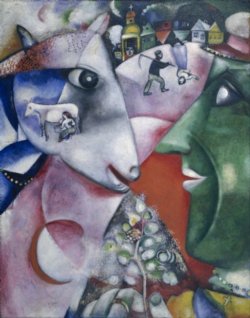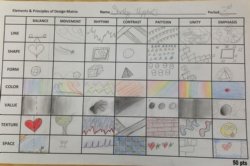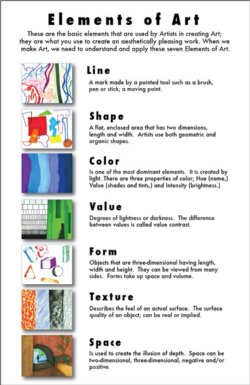Elements of Art



- What
- Elements of Art
- When
- 2/8/2022, 8:00 AM – 3:00 PM
- Where
- Art Room Hyde Park MS
Elements of Art
Look at the work of art above. Study it for a minute and notice how the artist has used each element of art.
The artist Name is: Mark Chagall – Title of the painting is: “I and the Village” – Created 1911 – Medium is: Oil on Canvas - Dimensions: 192.1cm ×151.4cm(75.6 in × 59.6 in). Location: Museum of Modern Art, NY.
The work is a Cubist style in construction and contains many soft, dreamlike images overlapping one another in a continuous space.
Assignment: Explain each number, what do you see and how and where the artist used each one.
1. Lines ___________________________________________________
2. Shapes ________________________________________________
3. Forms __________________________________________________
4. Colors _____________________________________________________
5. Texture _____________________________________________________
6. Value _____________________________________________________
7. Space __________________________________________________
8. What is the mood of the painting? _________________________________
9. What do you think it is about? ______________________________________________________________
10. Please explain in a few sentences what do you think about. _______________________________________________________________
Elements of Art
The elements of art are the building blocks used by artists to create a work of art.
Line is a mark with greater length than width. Lines can be horizontal, vertical, or diagonal; straight or curved; thick or thin.
Shape is a closed line. Shapes can be geometric, like squares and circles; organic, like free-form or natural shapes. Shapes are flat and can express length and width.
Forms are three-dimensional shapes expressing length, width, and depth. Spheres, cylinders, boxes, and pyramids are forms.
Space is the area between and around objects. The space around objects is often called negative space; negative space has shape. Space can also refer to the feeling of depth. Real space is three-dimensional; in visual art, when we create the feeling or illusion of depth, we call it space.
Color is light reflected off of objects. Color has three main characteristics: hue
(the name of the color, such as red, green, blue, etc.), value(how light or dark it is), and intensity(how bright or dull it is). • White is pure light; black is the absence of light. Both are NOT colors.
• Primary colors are the only true colors (red, blue, and yellow). All other colors are mixes of primary colors.
• Secondary colors are two primary colors mixed together (green, orange, violet).
• Intermediate colors, sometimes called tertiary colors, are made by mixing a primary and secondary color together. Some examples of intermediate colors are yellow green, blue green, and blue violet.
• Complementary colors are located directly across from each other on the color wheel (an arrangement of colors along a circular diagram to show how they are related to one another). Complementary pairs contrast because they share no common colors. For example, red and green are complements, because green is made of blue and yellow. When complementary colors are mixed together, they neutralize each other to make brown.
Texture is the surface quality that can be seen and felt. Textures can be rough or smooth, soft or hard. Textures do not always feel the way they look; for example, a drawing of a porcupine may look prickly, but if you touch the drawing, the paper is still smooth.
VALUE
Value is the lightness and darkness of a color. It can also make a flat, 2-dimensional shape have the illusion of a 3-dimensional form.
The elements of art are the building blocks used by artists to create a work of art.
The line is a mark with greater length than width. Lines can be horizontal, vertical, or diagonal; straight or curved; thick or thin.
The shape is a closed line. Shapes can be geometric, like squares and circles; organic, like free-form or natural shapes. Shapes are flat and can express length and width.
Forms are three-dimensional shapes expressing length, width, and depth. Spheres, cylinders, boxes, and pyramids are forms.
Space is the area between and around objects. The space around objects is often called negative space; negative space has shape. Space can also refer to the feeling of depth. Realspace is three-dimensional; in visual art, when we create the feeling or illusion of depth, we call it space.
Color is light reflected off of objects. Color has three main characteristics: hue
(the name of the color, such as red, green, blue, etc.), value(how light or dark it is), and intensity(how bright or dull it is). • White is pure light; black is the absence of light. Both are NOT colors.
• Primary colors are the only true colors (red, blue, and yellow). All other colors are mixes of primary colors.
• Secondary colors are two primary colors mixed together (green, orange, violet).
• Intermediate colors, sometimes called tertiary colors, are made by mixing a primary and secondary color together. Some examples of intermediate colors are yellow green, blue green, and blue violet.
• Complementary colors are located directly across from each other on the color wheel (an arrangement of colors along a circular diagram to show how they are related to one another). Complementary pairs contrast because they share no common colors. For example, red and green are complements, because green is made of blue and yellow. When complementary colors are mixed together, they neutralize each other to make brown.
The texture is the surface quality that can be seen and felt. Textures can be rough or smooth, soft or hard. Textures do not always feel the way they look; for example, a drawing of a porcupine may look prickly, but if you touch the drawing, the paper is still smooth.
VALUE
Value is the lightness and darkness of a color. It can also make a flat, 2-dimensional shape have the illusion of a 3-dimensional form.
- Elements of Art study.docx 19.38 KB
